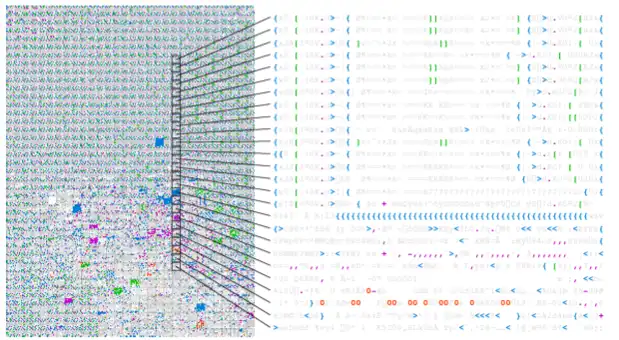In an experiment simulating what happens when a bunch of code strings are left alone for millions of generations, Google researchers claim to have observed the emergence of “self-replicators” from a non-self-replicating chunk of code. New Scientist magazine claims that this phenomenon is quite improbable, that it “mirrors, or at least sheds light on, the emergence of actual biological life.”
Hmmm. This is one of those studies where the experiments and findings are definitely felt to be consequential, but at the same time require some serious caveats. Google did not simulate the emergence of life as it happened on Earth. What the researchers did was to suggest a new theory of how non-living molecules come together to form living molecules, i.e., how biological life came into being. [This news comes from the recently published paper “Computational Life: How Well-formed, Self-replicating Programs Emerge from Simple Interaction.” The raw material for this experiment was tens of thousands of codes written in a programming language called “Brainfuck. The researchers call it an “esoteric language chosen for its simplicity” that allows only two mathematical functions: +1 or -1. These chunks of code were randomly mixed and matched, and for millions of generations “left to execute the code and override themselves and their neighbors at their own command.”
The expected result was not that the codes would all remain random with no particular trend. Instead, self-replicating programs emerged, replicating themselves over many generations, quickly reaching the upper population limit of the experiment.
Not only that. In the scenario described above, new types of replicators often emerged and in some cases surpassed and replaced the previous self-replicators. [One of the study's authors, Google's Ben Lowry, told New Scientist magazine that what makes this experiment special is that there are no parameters beyond randomness: “What makes this experiment special,” New Scientist said.
“I don't think anything magical is happening,” Lowry said. Physics occurred, and it occurred a lot over a very long period of time, and it created something very complex.”
Lowry goes on to say that scaling up the experiment in terms of adding more complexity to behaviors such as predator-prey relationships and timescales is unlikely to be feasible at current levels of computing power.
Dr. Richard Watson, an evolutionary scientist specializing in the algorithmic foundations of life and society, says this is all “very cool” but will soon be doused with cold water.
“The complexity they measure rises after self-replication begins. But it's not clear whether it will 'take off' in an interesting way,” Watson says.
“Self-replication is important, but it would be a mistake to believe that it is a magic bullet from which everything else exciting about life automatically follows.”
More positive, however, is the opinion of prominent computer scientist Professor Susan Stepney, who calls the experiment that created the self-replicating device “a great achievement.”
“This is certainly a major step toward understanding potential pathways to the origin of life in a medium quite removed from the standard ‘wetware’ of biology.
Certainly the Googlers feel they have discovered something important, but it may be a bit wild to extrapolate from there. As for the latter, the fact that the research team chose terms like “primordial soup” definitely does not help, since people know what to infer from it. As to whether this research is a stepping stone to understanding how organic molecules were formed in the first place, see ...... We will have to wait for a few more generations of computational power.
.

Comments